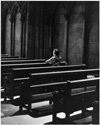Most of us are slaves to fashion in one way or another. If we are not among those who are required to wear a certain style of clothing "appropriate" for our workplace, we still find a way to fit in with the people with whom we associate. Even the young rebels of each generation seem to find togetherness in fashion no matter how foolish or outlandish it may seem to the older generations.
Museums are good places to study past fashions as depicted in portraits and when hung on hangers or mannequins.
Episcopal churches and seminaries are other places you might visit to see strange characters in historical costumes.
With apologies to Bishop Dan Martins and his friends, I maintain that certain clerical costumes have lost their historical significance and instead send the message that the wearer is someone who you shouldn't take too seriously.
Defenders of elaborate robes and funny hats go through all kinds of mental gymnastics in order to justify their penchants for continuing to play dress up well beyond their childhood years.
Of course, this issue is not limited to the Episcopal church. Back in 2008 the Roman Catholic Fr. Dwight Longenecker presented his justifications of priestly attire in an article at Patheos.com entitled, "Why Wear All those Robes?…"
"The priest’s vestments are a ceremonial costume. They are meant to effectively obliterate the priest’s personality. They are also, by the way, meant to be unobtrusive. They should not be creative or clever or call attention to the smart vestment designer or the wonderful seamstress. They are simply to dignify the office of the priest and dignify and beautify the celebration of Mass."Unfortunately, many of the costumes we see our clergy wearing draw more attention to the celebrant than to the Mass.
"If the Mass is the Royal Marriage Feast of the Lamb, then the priest should dress up for his entrance into the royal court. The robes should therefore be regal in their dignity, their simplicity and their style. As much as possible their beauty should be shown, not by cleverness of design or ornamentation, but through quality materials and fine workmanship."Holy jeans won't cut it. I will grant him that.
"Why should the priest dress like a king? Because he reminds the whole people of God that they serve Christ the King, and the priest is in persona Christi."Actually, the priest serves in persona Christi. That does not mean that he has to dress like a king. If anything, it might suggest that he should wear sandals and a simple robe.
"Furthermore, they remind the people of God that they too are a chosen people, and a royal priesthood. The priest focuses in his own person and ministry the royal priesthood of the people of God."That is one reminder that never made its way down to this pew.
"Furthermore, when the priest dresses in fine robes he symbolizes the riches of grace bestowed upon the people of God." Over the black cassock of his sinful human condition the priest wears the white alb–the symbol that he, (and his people) are clothed in the righteousness of Christ by virtue of their baptism. Over that he wears a splendid chasuble to show that the final state of the Christian is not just the white robes of Christ’s righteousness, but a share in Christ’s own royal priesthood. Each of the faithful are princes and princesses–adopted into the royal family."That is his story and he is sticking to it.
Fr. Dale Matson over at the Soundings blog recently wrote, and I take this out of context because I think elaborate costumes do something to the wearer's sense of humility,
"Good theology is God centered. Theology that is man centered makes God in the image of an idealized man. When man is god, the material earth becomes his kingdom and it is more important to save the earth that humans may "flourish" than to save souls for the Kingdom of God."Do our fancy dress up clothes make us think we are king-like. or do they reflect an inner desire to be God-like?
While I have heard some Episcopal clergy complain about the cost, the weight, and the warmth of their elaborate outfits, I don't see many of them ditching the fancy dress for something more practical and less silly looking.
Maybe they just like playing dress up, and that leads me to another of my pet theories: "Is there a certain personality type that is attracted to ministry in the Episcopal church that might explain why our priests and bishops wear those silly costumes and might this also explain why the church is prone to drink from the cup of alternative sexual identities and novel marriage arrangements?"
What if the more virile type is attracted to the robes,
Just don't get me started on the personality profiles of female bishops.
Whatever you decide to dress up as this week, after reading this, I'll bet you won't dress up as a bishop.
Happy Halloween everybody!





I would like wearing a cassock except for all those buttons. Those in the the lay order may also wear cassocks, for example, when they lead morning prayer. The priest's stole represents the yoke of Christ. For me, the concept of sacerdotal doesn't mix with a business suit.
ReplyDeleteEach cassock button represents a year of our Saviour's life on earth.
DeleteIn buttoning all 33, one could spend time contemplating each year. That could be a prayer or meditation in itself, which was probably the original intent.
The five buttons on the sleeves represent His wounds for our sake.
http://www.semcasual.org/the-cassock-sign-of-love/
Churchmouse
Keep it simple might be the wisest advice. As someone reported to me via e-mail, Bishop John A. Pinckney (Upper south Carolina) 1905-1972 stopped wearing his red cope and mitre in processions when a child cried out in delight: “Here comes Santa Claus!”
ReplyDeletePewster,
ReplyDeleteRegarding your comment. Thank You God for not allowing me to pluck from the low hanging fruit that is so abundantly available.